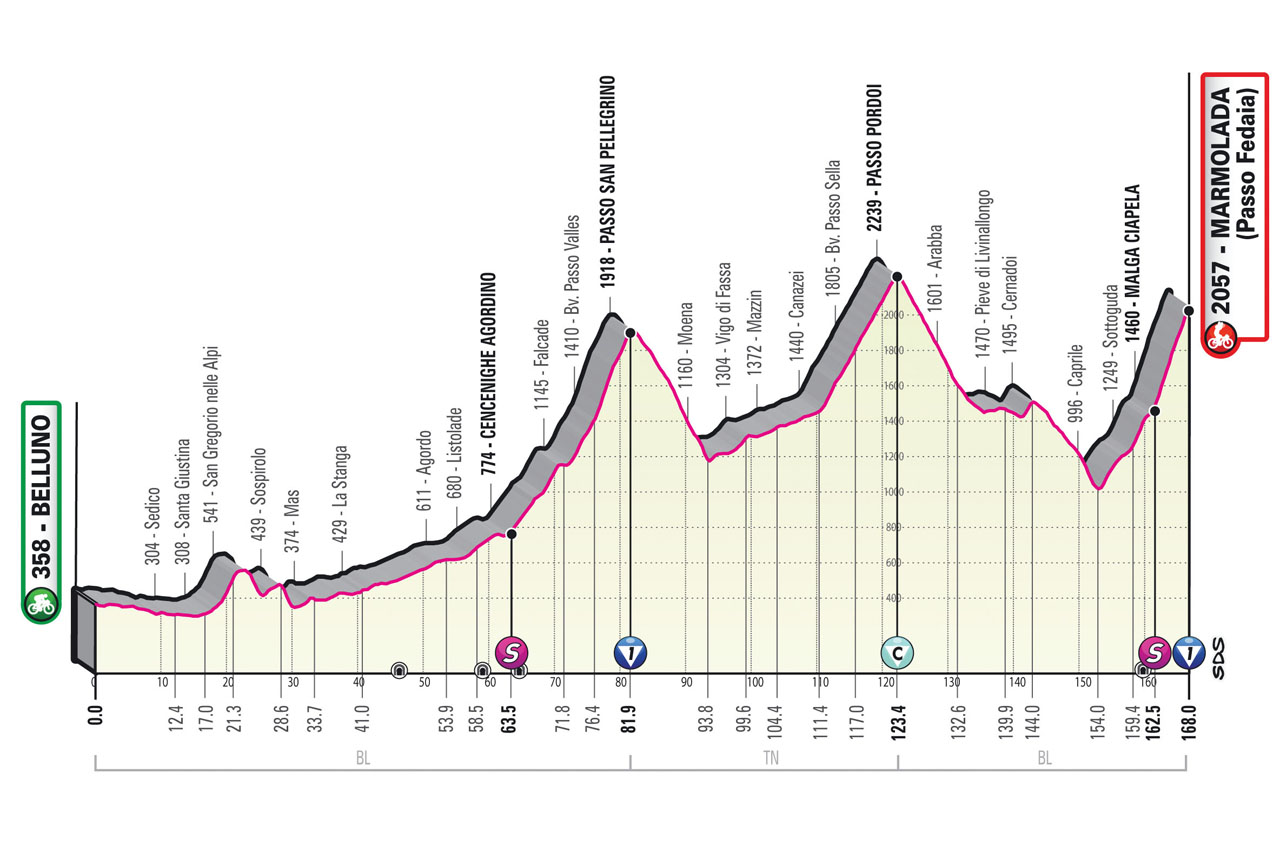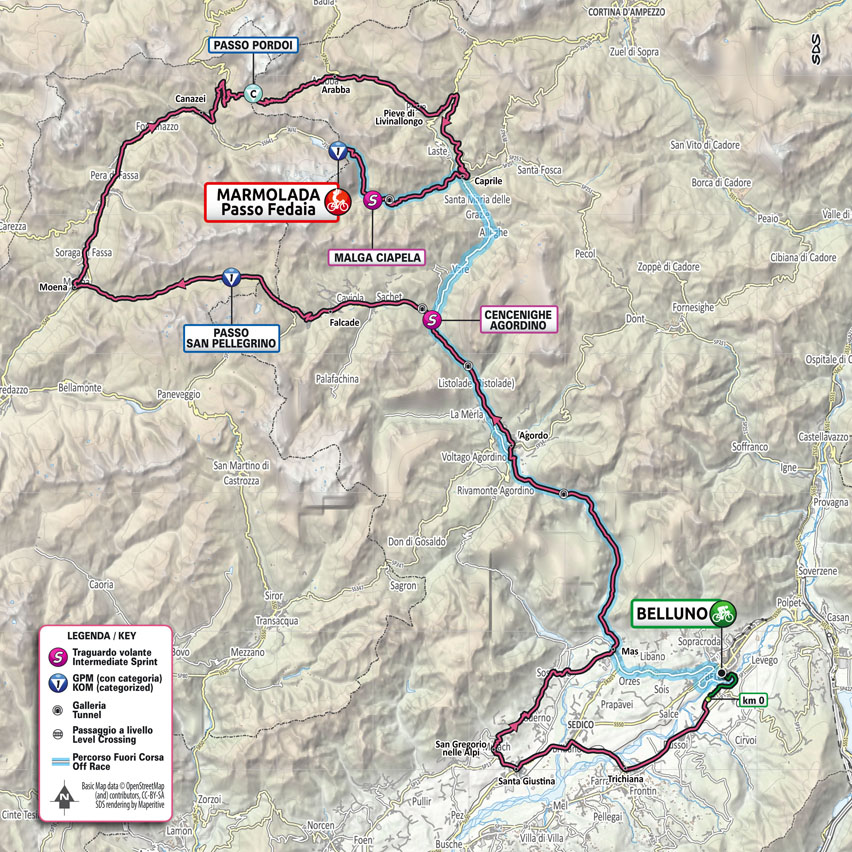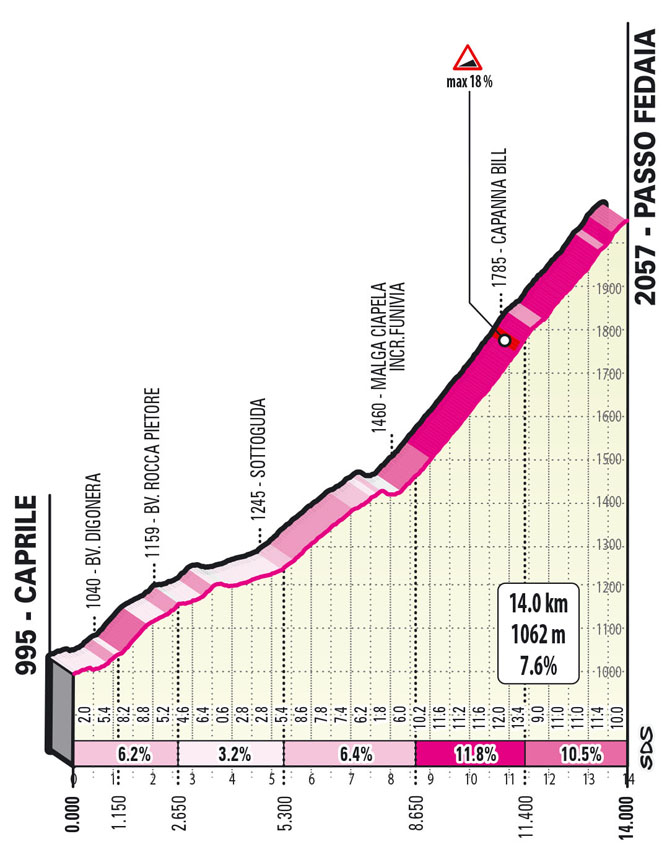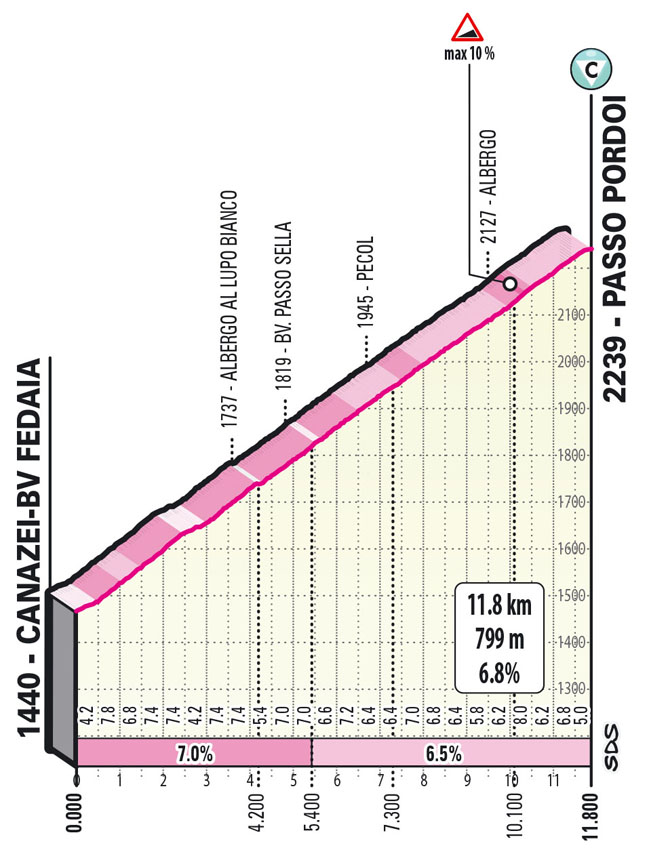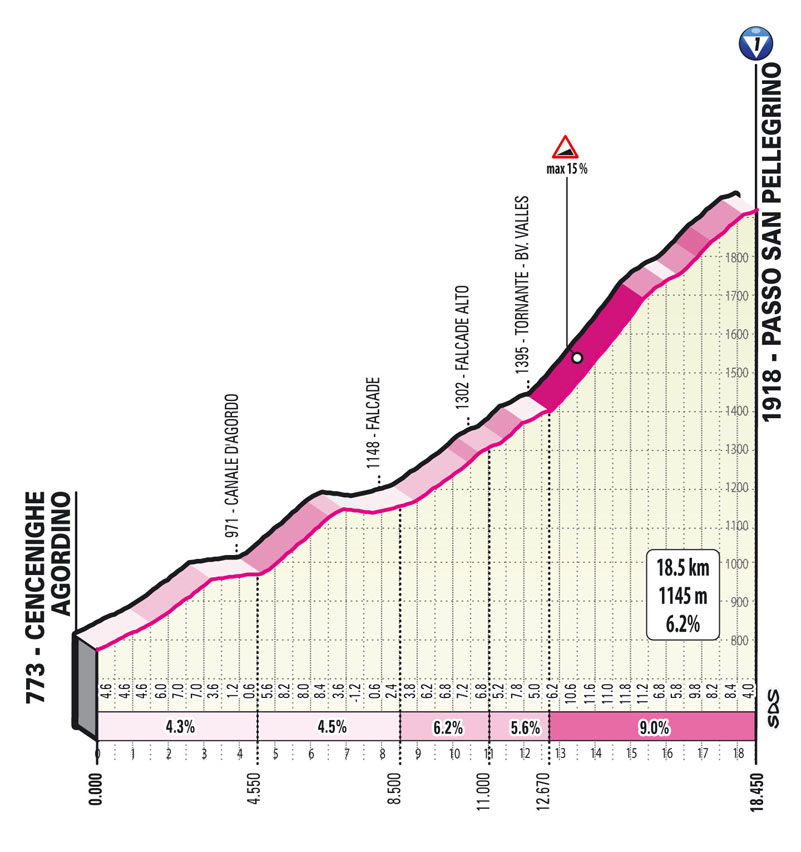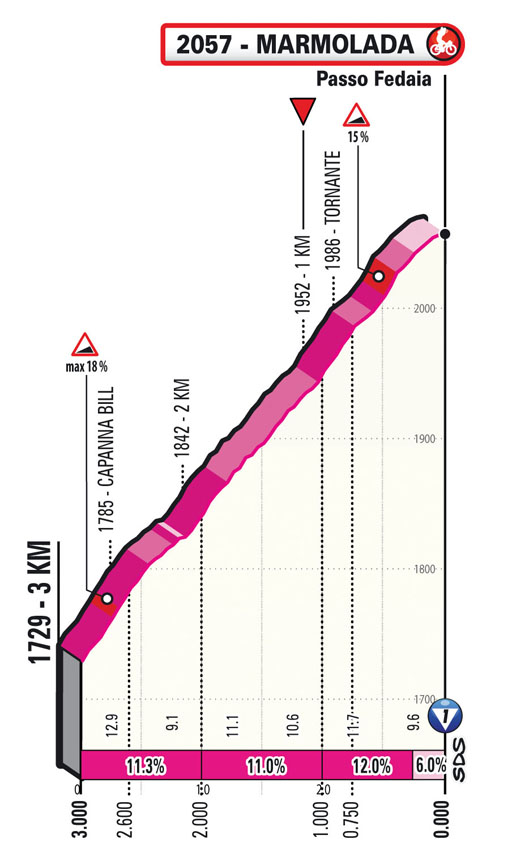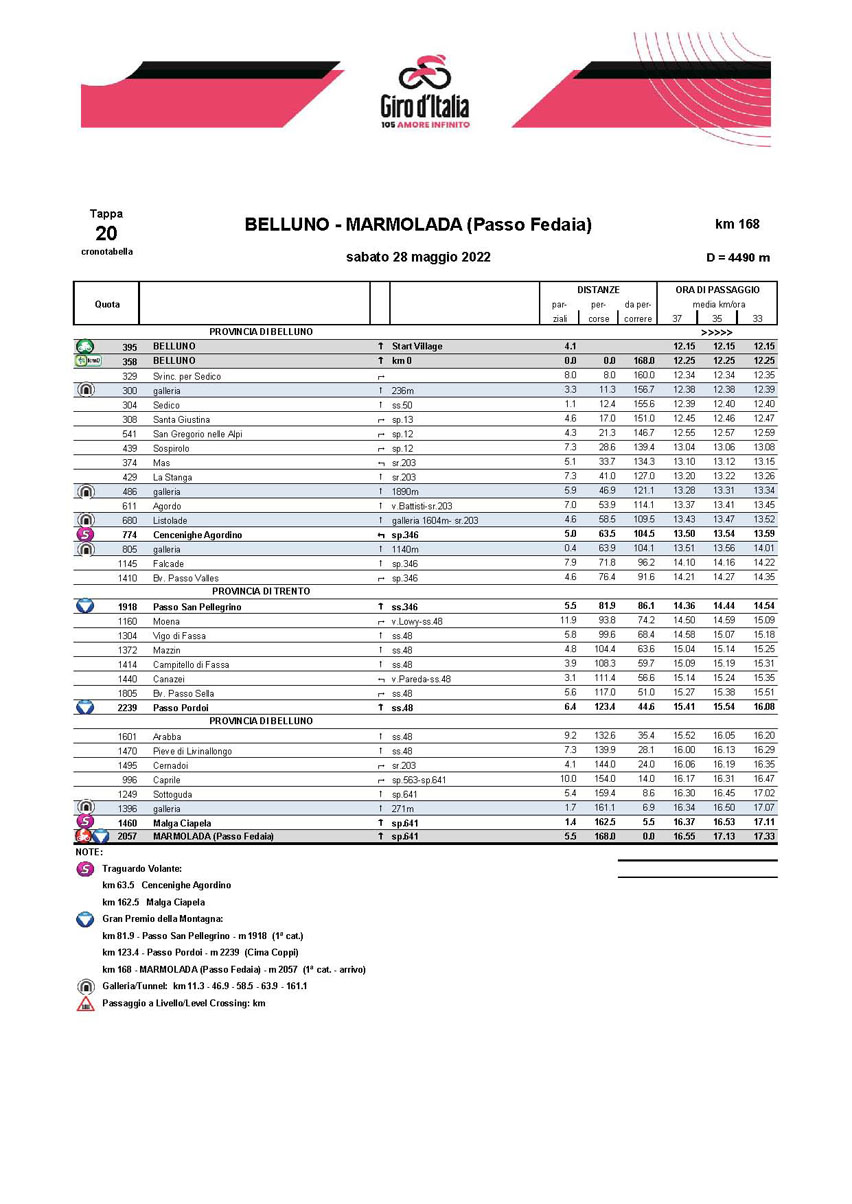profile
map
technical info
The route
A colossal stage through the Dolomites, and the last summit finish of the 2022 Giro d’Italia. Starting in Belluno, and taking a short diversion across the valley of the Piave river through Sedico, Santa Giustina and Sospirolo, the route passes Agordo and Cencenighe, crossing the Val Cordevole upstream. The stage finale features three consecutive climbs: Passo di San Pellegrino (with gradients exceeding 15% past Falcade), Passo Pordoi (the 2022 Cima Coppi), and Passo Fedaia, where the gradients hover steadily above 10%, topping out at 18% in the 6 km past Malga Ciapela.
Final kilometres
The ramps are steep over the last 14 km. After a technical ascent from Caprile to Rocca Pietore, the route becomes a 2% false-flat up. The gradients go up again past Sottoguda, then the road dips a little before Malga Ciapela (passing through a curved, well-lit tunnel). The average gradient over the last 6 km is around 12%, with a mid-climb 18% peak. The home straight is flat, on tarmac road.
start / finish
climb detail
final kilometres
itinerary timetable
tourist info
Host city:
Belluno
Touristic Information
Belluno, the shining city! This is how the Celts called it: about an hour from Venice, perched on a promontory and lapped by the Piave River and the Ardo creek, Belluno is the capital city of a natural heritage that has no equal in the world, the UNESCO Dolomites. Steeped in history and naturally devoted to nature, our territory can give unique experiences and emotions.
In Belluno nature meets the city: on the one side the Pre-Alps with their gentle slopes and their bright green, on the other the UNESCO Dolomites, a unique scenery made of majestic rocky walls and monumental peaks stretched towards the sky. Through the valley flows the river Piave, iconic World War I battlefield. A historical city center skimmed by waters and crowned by mountains.
An open-air gym: this is what the Belluno area turns into during summer. Trails through the mountains surrounding the city, some of the most challenging vie ferrate and the iconic Alta Via delle Dolomiti n.1, and plenty of cycling routes for the two wheels enthusiasts, and also downhill slopes in Nevegal hill, which in winter turns perfect for winter sports enthusiasts.
Gastronomy
The traditional cuisine is very tasty: the pastin, for example, is the king of our barbecue and it is made of spicy beef and pork minced meat. From the rich dairy tradition comes schiz, a first salt cheese best baked in the oven. Dessert addicted need to try giuseppine during Carnival or the spicy Pan de Belun, but if you prefer a healthy but tasty snack kodinžon, a dried apple stick, is the one for you. Obviously, all soaked by a classic ombra of wine or a handcrafted local beer.
Main sights
HISTORY, ART AND NATURE
The city center of Belluno will surprise you: immerse yourself in the old town, going down to Rugo gate and then coming up to Dojona gate or Dante gate, from which Martiri Square will open up with its gardens and its porticoes full of shops and cafes. You can then proceed towards Santo Stefano Square and its gothic church, which is definitely worth a visit.
Martiri Square, once called Campedel, is the main meeting point for locals, whereas the solemn heart of Belluno beats in Duomo Square with the Cathedral, the Rettori Palace and the town tower dominating the scene. A short distance away, in Castello Square, you’ll find the overlook on the river Piave from where you can admire the birth home of Dino Buzzati in the background: he was a famous journalist and writer and his love for the Dolomites is traceable throughout his whole literary production. Unmissable are also the art treasures of the town museum, Fulcis Palace, one of the most beautiful and elegant buildings in town.
The city is rich of fountains, and the small villages in the surroundings are also enriched by fountains and stone wash houses. On the bank of the river Piave rises Borgo Piave, foothold for the rafts that used to provide wood for the Republic of Venice. In Borgo Pra, instead, the energy produced by the Ardo creek made the fortune of the small workshops that grinded cereals, kneaded wool, tanned leather, cut wood and produced the famous swords that during the 16th and 17th centuries were well known throughout Europe.
Belluno is a town rich of history and culture and the town museum is the perfect witness of such a heritage: one of the most beautiful buildings in Belluno where you can admire the pieces of the most eminent local artists, from Andrea Brustolon to Sebastiano Ricci. Belluno was a land of migration and the memories of those who had to leave their country are collected at the Migrations Museum.
Belluno is also nature: just outside the city, towards Bolzano Bellunese, you’ll find Case Bortot, starting point of several trails. Don’t miss the one to the Bus del Buson, a spectacular canyon engraved the Ardo creek.
Belluno is the only Province Capital whose land is part of a National Park: the Dolomiti Bellunesi National Park. The highest peak of the Park and one of the symbols of Belluno is Mount Schiara (2565 mt). Next to it, you can admire the Gusela del Vescovà, a 40 mt high rocky spur that stands out in vertical.
Marmolada
Touristic Information
The municipality of Rocca Pietore (La Ròcia in Ladin) is the Geographical heart of the Unesco Dolomites. Situated 1143 m above sea level, it has about 1200 inhabitants and 76 square kilometres of surface area.
The area is famous for its natural elements where you can enjoy an authentic experience of forests, enchanted lakes, villages and some of the most majestic Dolomite peaks.
Rocca Pietore offers a wide range of experiences linked to sport, history, culture and wellbeing.
The Marmolada Ski Area, part of the Dolomiti Superski, is the jewel in the crown for winter skiing, but the valley also offers the chance to try out ski mountaineering, cross-country skiing, freeriding, snowshoeing and ice climbing. Some of the most scenic treks in the Dolomites, adrenalin-pumping crags and via ferratas: summer is also more active than ever here.
The history of the community of Rocca Pietore has passed through important human events: the Magnifica Comunità della Rocca, a form of self-government in the Longobard period, and the First World War, fought among these harsh rocks. An important part of this history is witnessed with war findings inside the Marmolada Great War Museum at Punta Serauta, in Marmolada.
The hotels, flats and B&Bs reflect the authenticity of the environment that surrounds them, adding that familiar welcome that makes guests feel at home. Since 2018 Rocca Pietore has been an Orange Flag municipality of the Italian Touring Club for the quality of tourist accommodation.
Gastronomy
The cuisine and typical gastronomy of the Dolomites are key elements for the Ladin identity of the Rocca Pietore area.
The ancient agricultural roots of the area gave the healthiest ingredients to the local recipes: most of all potatoes, vegetables and cereals. These elements have the strength to grow up also at high altitude, with a fresh climate.
The crops made possible by the Dolomite climate are those that do not require great heat and that withstand the temperature changes present at high altitude.
Ladin cuisine is a journey through culture and flavors, an experience that will take you by the throat and will give you unique sensations: from the particular flavor of game meat with polenta to the sweetish aftertaste of smoked ricotta, from the spice of typical desserts to perfume and grappa flavored with cumin, mountain pine, juniper, blueberries and wild strawberries.
Cereals such as barley, wheat, rye, oats and legumes, vegetables such as peas, beans, turnips and potatoes and still apples, plums, apricots, berries, strawberries and mushrooms from the undergrowth: these are the products of the earth, processed with care and dedication by local cooks and chefs.
And again cheeses and dairy products. Great attention is given to their preparation from the malghe of the area. Spicy, seasoned or fresh, soft or more decisive: the tasting of local cheeses offers a riot of flavors that cannot be renounced.
From lunch in a refuge as a well-deserved reward after a wonderful trekking among the most beautiful valleys of the Dolomites, to a convivial evening in one of the restaurants in the valley and even to a sophisticated dinner: every occasion is good to regenerate yourself at the table and to savor the typical tastes of the area.
Here’s a taste: the dumplings, known as balòte or bale, offered in broth or with melted butter, with speck or with spinach and ricotta, or with cheese; the casonzièi o casunziei, egg pasta crescents stuffed with spinach and ricotta, pumpkin, beetroot or potatoes; local potato gnocchi with melted butter and smoked ricotta; the menèstra da orz with smoked pork knuckle.
Beverages
The cuisine and typical gastronomy of the Dolomites are the key elements for the Ladin identity of the valley.
After having tasted the traditional dishes, skilfully prepared and served by the chefs of the valley, how can one not end a convivial lunch or dinner in style or an apreski on the slopes with an aromatised grappa? Cumin, mugo pine, silver fir, juniper, blueberries and wild strawberries are the sensational products that fill each glass with unique scents and tastes. The combination of grappa with herbs, roots and wild fruits is of ancient origin and the territory offers an infinite variety.
An increasingly popular trend is the use of elderberry, a plant that flowers in May and whose flowers are used for syrups and whose berries are used for delicious jams.
Particularly in summer, the syrup is consumed either as a simple refreshing drink or added to prosecco and mint leaves for a delicate but strong aperitif.
Mulled wine, also known as spiced wine, is a typical drink to warm up the cold winter days and to envelop the senses in spicy scents and aromas. The recipe for this wine has been handed down over the years without major variations: citrus fruits, cinnamon, cloves, oranges and red wine have remained the basic ingredients for a pleasant convivial break with a low alcohol content.
Main sights
Rocca Pietore abounds with many times prized hamlets and authentic villages scattered throughout the territory, each with its own particular history and landscape: from the legendary village of Bramezza to the panoramic Laste, from the main town to Malga Ciapela, from Sottoguda to Palue. And then there is Calloneghe with its view of Lake Alleghe and the majestic wall of Mount Civetta.
The municipality of Rocca Pietore has a total of 25 small hamlets to discover!
Two small treasure chests of history and culture, Sottoguda and Palue, in the élite of the Most Beautiful Villages in Italy since 2016, take the guest on a journey through colours, artistic works and authentic views. A visit to the craft workshops, internationally renowned for their wrought iron and woodworking, is a must. Famous are hand-painted butterflies, but also true works of art shaped by the craftsmen’s hands. From a tree trunk come the faces of gnomes with long beards, goblins and beautiful nymphs, guardians of an enchanted and not yet lost kingdom, inspired by legends. Innovative is the creation of jewellery in beech wood and crystals skilfully set one by one to embellish and give light to necklaces, bracelets and earrings.
Among the historical monuments, the church of S. Maria Maddalena in Rocca Pietore, built in 1442 in Gothic style, is characterised by its Ghibelline spire bell tower. Inside you can admire the altarpiece dating back to 1517 and the tabernacle made in 1600. Definitely worth a visit are the small church in Sottoguda dedicated to Saints Fabiano, Sebastiano and Rocco and built to fulfil a vow made by the population spared from a plague epidemic, the sanctuary in veneration of the figure of Mary Help of Christians in Santa Maria delle Grazie, a pilgrimage destination every year for believers from various places and the church in Laste dedicated to San Gottardo, located on the characteristic Col da Gejia and built in 1863.
At Malga Ciapela, both in summer and winter, the Marmolada – Move to the Top cable car allows you to reach the panoramic terrace of Punta Rocca in a few minutes and to visit the Marmolada Great War Museum 3000 m at the intermediate station of Serauta. Here in summer you can also visit the Sacred Monumental Zone while in winter it is a destination for skiers who enjoy the fantastic panorama from the Queen of the Dolomites down La Bellunese, the longest slope of the Dolomiti Superski.
Starting from Malga along provincial road 641, it takes just a few minutes to reach the Fedaia Pass.
In Rocca Pietore you can live unique and exciting experiences: the history, but also the culture, the uncontaminated natural environment, the countless sports that can be practiced both in summer and in winter, the Ladin tradition that can be breathed in the traditions, the language but also in the good food. The peace and tranquillity of an authentic place and the simple but attentive hospitality guarantee guests a truly regenerating holiday































